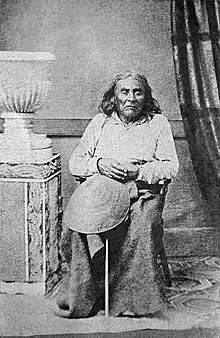A daily study of the Network’s diverse faiths

Chief Seattle (Se – Se) (c1786-1866). Evangelical Lutheran Church in America Commemoration of death of chief of the Duwamish Confederacy, a leader of noble Suquamish and Duwamish parentage who was born on Blake Island, Washington, New Spain and after whom the city of Seattle (Si’ahl, Duwamps), Washington State is named. Known as an orator, he argued for ecological responsibility and respect for Native Americans’ land rights and pursued a path of change with the white settlers. Chief Seattle had earned his reputation at a young age as a leader and warrior, ambushing and defeating groups of tribal enemy raiders. Like many of his contemporaries, he owned slaves captured during his raids and the Hudson’s Bay Company called him Le Gros (The Big Guy). Chief Seattle was converted to Christianity by French missionaries and baptised in the Roman Catholic Church in 1848 with the baptismal name of Noah. He kept his people out of the 1856 Battle of Seattle and was unwilling to lead his tribe to the reservation then established, the government allowing him to move to his father’s longhouse. Seattle visited the town named after him and died on the Suquamish reservation at Port Madison, Washington. Resting place Port Madison. In 1890, a group of Seattle pioneers set up a monument over his grave, with an inscription identifying him as the firm friend of the whites. The site was restored and a native sculpture added in 1976 and again in 2011. The Suquamish Tribe honours Chief Seattle each year in the third week of August with Chief Seattle Days. Image:seattletimes.com.

Seliger Franz Jägerstätter (Blessed Franz Jaegerstaetter OFS, Franz Huber) (1907-43). Feast Day commemorating nullification of Nazi death sentence on poor Austrian farmer who was a conscientious objector during World War II and was sentenced to death and martyred for his refusal to fight for Nazi Germany. After his Maundy Thursday 1936 wedding, he went with his deeply-religious wife on a pilgrimage to Rome and they received a papal blessing. When German troops moved into Austria in 1938, Jaegerstaetter rejected the offered position as Radegund mayor and was the only person in the village to vote against the Anschluss in the plebiscite. He was dismayed to witness many Catholics supporting the Nazis, writing: “I believe there could scarcely be a sadder hour for the true Christian faith in our country.” In 1940, he joined the Third Order of Saint Francis and from summer 1941 worked as a sacristan at the local parish church, military service being deferred 4 times. Drafted at 33, he had refused to take the Hitler oath and returned to his wife and 3 daughters on their farm, where he saw reports of the Nazi euthanasia programme but found that his Bishop seemed afraid to confront the issues. Called to active duty in 1943, he declared his conscientious objection and was immediately arrested and taken into custody, a priest from his village trying unsuccessfully to talk him into serving. Accused of Wehrkraftzersetzung (undermining of military morale), Jaegerstaetter was sentenced to death for sedition, deported to Brandenburg-Görden Prison and executed by guillotine at 36. Minutes before his execution, he was given the option of signing a document to save his life but he declined, to avoid any complicity with the Nazi regime. Jaegerstaetter’s last words were: “I am completely bound in inner union with the Lord”. In 1946, his ashes were buried at the Sankt Radegund cemetery, his name not being put on the local war memorial and a pension for his widow not being approved until 1950. The death sentence was nullified on 7 May 1997. A Stolperstein sett-sized 10 cm concrete cube bearing a brass plate was laid for Jaegerstaetter in Sankt Radegund in 2006. Honoured in Secular Franciscan Order of Catholic Church. Feast Day on 21 May date of baptism. Patron of conscientious objectors. Image: heiligenlexicon.de.

Naomh Mo Cholmóc de Druimm Mór (St Colmán of Dromore) (c450-c520). Feast Day for Dalriadan (Dál Riatan) Irish baptised Celtic Christian educated at the monastic foundation at Nendrum on Mahee Island, Strangford Lough that had been founded by St Caolán (Mochaoi), Abbot of Nendrum. Caolán was so impressed by Colmán’s potential as a Christian Apostle and by his miracles that he sent him to visit various other monasteries to study Holy Scripture, religious practice and forms of community life. Colmán spent some years in the mid-470s at the great school of Emly, County Tipperary. In the early-6th-Century, he acted as an assistant in the school at Nendrum, among his many pupils being St Finnian of Movilla. He was the first Abbot of Muckmore, County Antrim and then settled at Dromore, County Down, where around 514 he built a small wattle and daub church thatched with reeds. His followers observed a very strict Rule of discipline and St Finnian established a monastery at Movilla, County Down (Mainistir Mhaigh Bhile, Monastery of the Plain of the Notable Tree). During Colmán’s lifetime, Dromore Abbey became an Episcopal See and Colmán became Abbot of Dromore and Bishop of Down. Venerated in Roman Catholic Church. Patron of Roman Catholic Diocese of Dromore. Image: catholicireland.net.
Prayer When Ireland’s Enlightener returned to his native land he found at Emly the church built at the bidding of an Angel by a wise shepherd of souls and glorious ascetic. O illustrious Patrick, pray to Christ our God that we might also become bastions of Orthodoxy and a shining example to our fellow countrymen, drawing them away from ignorance and error and into the true Faith so that all our souls may be saved. Amen
